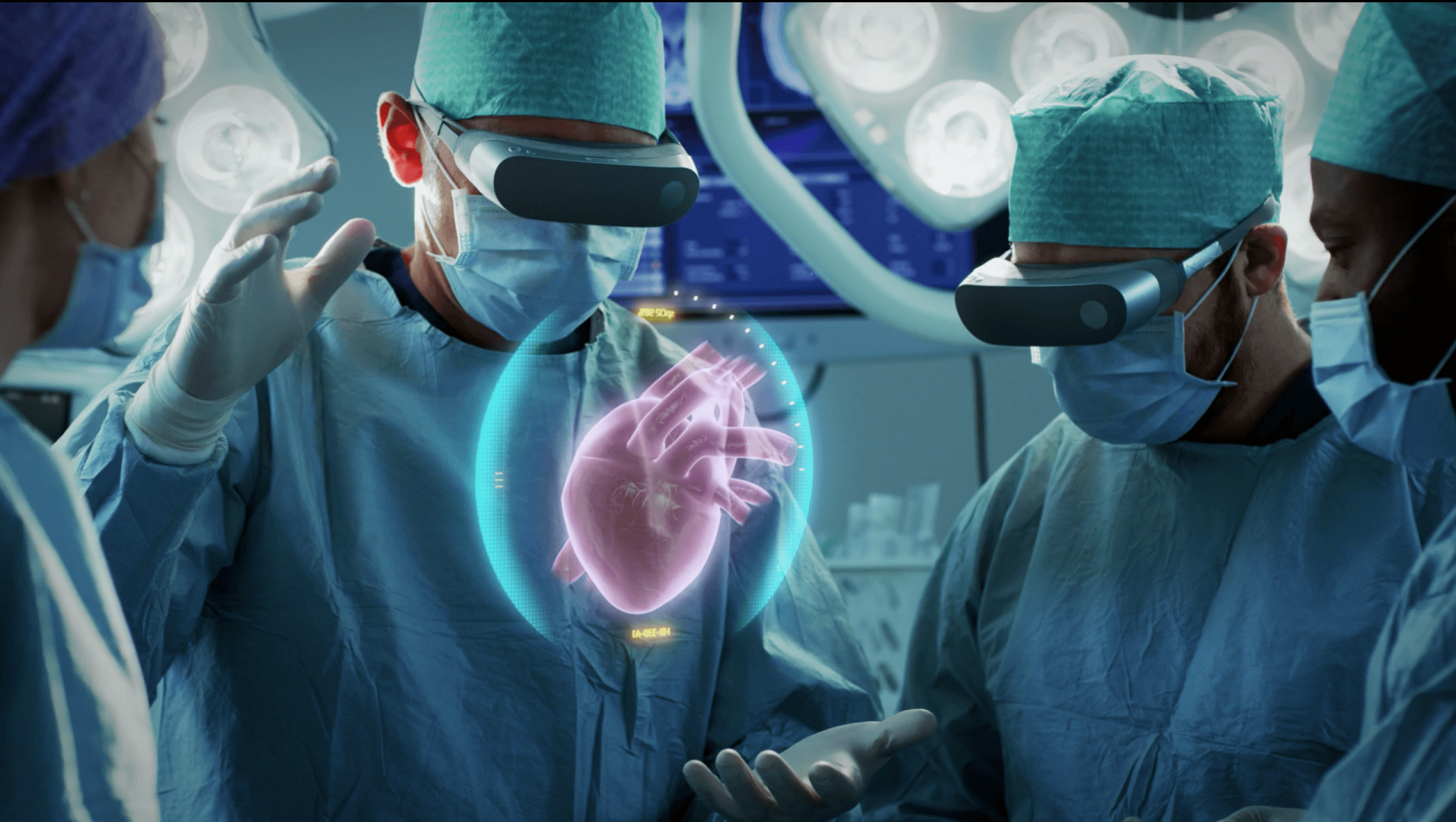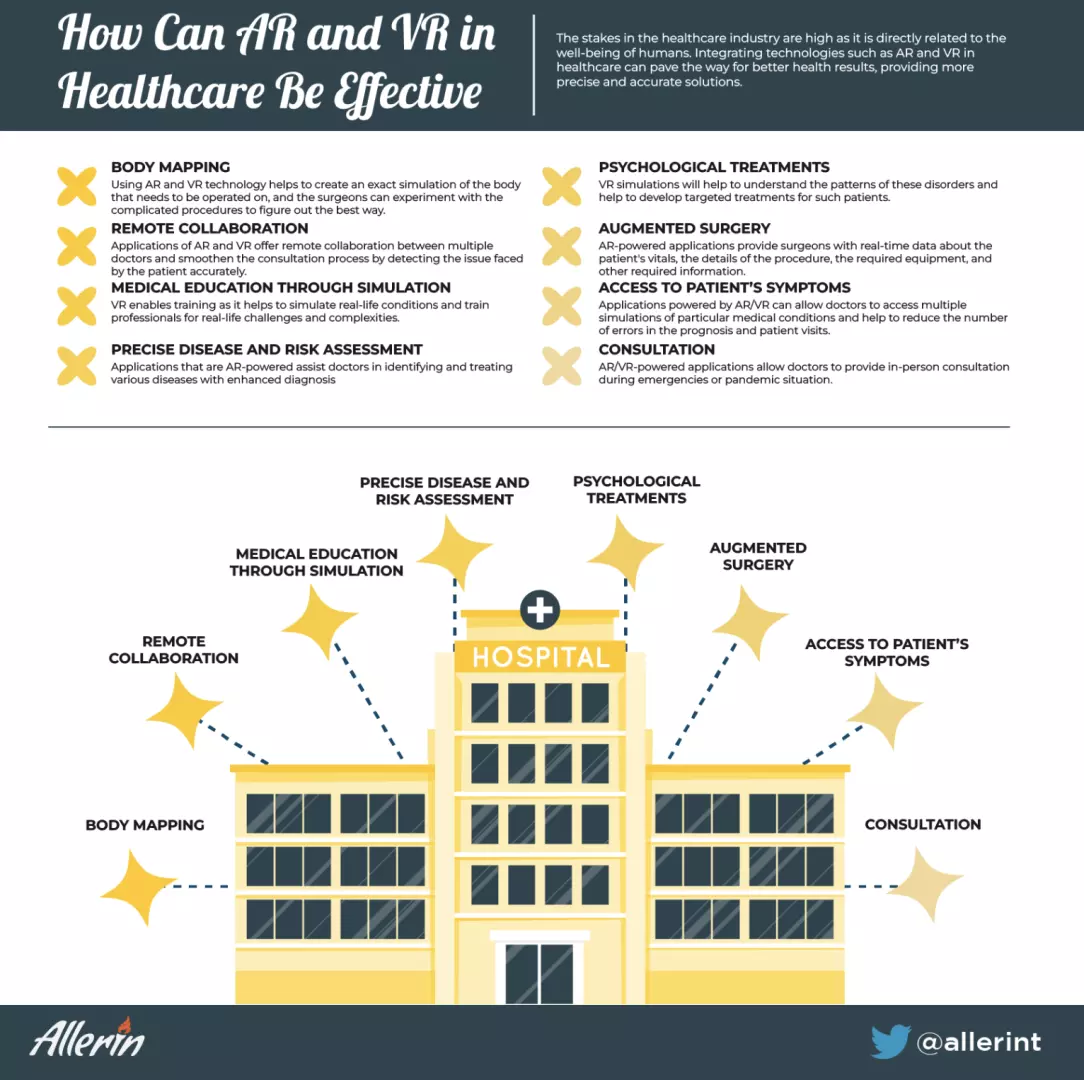Comments
- No comments found

The stakes in the healthcare industry are high as it is directly related to the well-being of humans.
Integrating technologies such as AR and VR in healthcare can pave the way for better health results, providing more precise and accurate solutions.
ome time ago, Virtual Reality and Augmented Reality technologies were limited to the gaming industry. Now, as the world all around is becoming more digitized, many industries are integrating the technologies of AR and VR in their workings and achieving what seemed a far-fetched reality. One such industry is healthcare. It is reported that the market for AR and VR in healthcare is going to reach around 9.7 billion dollars in the coming five years. The current value is approximately 2.7 billion dollars. This means that the industry will grow 3.5 times by the year 2027.
All healthcare systems come with their own set of challenges. Issues could range from the patient being situated in a difficult-to-access area or having limited availability of space and equipment, and skills. Some equipment may be outdated or obsolete, which makes the practitioner's task quite difficult and can endanger the patient. One perpetual challenge is the lack of availability of staff. Training and educating medical practitioners require a lot of time, and they can't be asked to jump into any cases in real-life until and unless they have the required skills. However, a lot of these problems can be mitigated if AR and VR technologies come into play. AR and VR-powered tools can empower doctors to understand complex procedures and perform them on the patient. Educating and training professionals can also be simplified using immersive technologies as it will provide a near-real simulation and a broader understanding and knowledge of the human body.
These technologies can also significantly improve the experience of a patient and a doctor by adding navigation features and pop-up information. This allows the patients to help locate where they can find the particular doctor. AR and VR-enabled applications can critically improve the overall effectiveness of medical services.
There is a rise in the use of VR and AR technologies in medical education. Surgeons, doctors and medical students can learn to effectively execute their patients' complex surgeries and not subject them to any risks.

There are frequent situations where surgeons are faced with complex surgery. In such cases, they need to be absolutely sure that they will be able to perform the surgery. Using AR and VR technology helps to create an exact simulation of the body that needs to be operated on, and the surgeons can experiment with the complicated procedures to figure out the best way. It can also aid in case the doctor cannot examine the body physically. This helps to provide the patient with the best possible result while keeping them out of danger.
Applications of AR and VR offer remote collaboration between multiple doctors and smoothen the consultation process by detecting the issue faced by the patient accurately. They also provide conferences and collaborative remote surgeries between medical practitioners based out of different locations working on related medical problems. One such technology is called Proximie. It allows doctors to scrub in virtually during surgery and provides the surgeons with virtual hands-on assistance.
One of the major challenges that the healthcare industry faces is the lack of trained and skilled professionals. Implementing AR and VR solutions can ease the entire process of educating and training. VR is an effective way of studying and understanding the human anatomy by going through each layer and also understanding how it functions. VR enables training as it helps to simulate real-life conditions and train professionals for real-life challenges and complexities.
Applications that are AR-powered assist doctors in identifying and treating various diseases with enhanced diagnosis. They help to collect information from different sensors in a single interface and provide visualization to understand the exact reasons for the patient’s symptoms. They also allow us to monitor and examine organs, veins, etc., without doctors needing to conduct invasive procedures.
The use of immersive technologies such as virtual and augmented reality also helps in providing psychological relief and treatments. Specific virtual environments can be created to help patients plagued by certain mental conditions such as phobias, addictions, or anxiety. One such application is Oxford VR. It allows patients with any psychological disorders and provides them with a safe environment to overcome them, as it is done virtually. These VR simulations will help to understand the patterns of these disorders and help to develop targeted treatments for such patients. It can also pave the way to reducing pain and improving the patient’s sleeping patterns.
To help improve the safety of patients, AR-powered applications provide surgeons with real-time data about the patient's vitals, the details of the procedure, the required equipment, and other required information. These AR-enabled virtual interfaces help surgeons to visualize and locate the tumor, abnormalities, or any other diseases. This helps to quicken the procedure while keeping the patients out of danger.
Applications powered by AR/VR can allow doctors to access multiple simulations of particular medical conditions and help to reduce the number of errors in the prognosis and patient visits. Numerous diseases can be cured and prevented accurately via AR-powered mobile applications, which also makes patients self-sufficient in taking the necessary cautionary measures while in the process of recovery. This increases the ratio in patient consultation with the time taken and avoids unnecessary doctor visits various times a week.
AR/VR-powered applications allow doctors to provide in-person consultation during emergencies or pandemic situations. Essential services like vitals monitoring, immediate remedies, pulse examination, poisoning cure, etc., can be delivered virtually. If a person is experiencing any discomfort, the same can be checked out using AR-powered tools to help the patient and doctor save time and energy.
The Healthcare industry has been one of the most impacted industries when it comes to implementing technologies and yet is slow to embrace VR and AR due to challenges such as lack of awareness and insufficient finances. However, as the years progress, implementation and investment in these immersive technologies in the medical industry are going to become a reality. If implemented correctly, AR and VR in healthcare can be a great boon. Teaching and training medical professionals will also become simplified yet enhanced. Consulting with a doctor will become convenient, and the pressure of diagnosing patients will reduce. Doctors can also collaborate on complex but related procedures, provide the patient with the best possible result, and achieve successful surgery. Immersive technologies such as AR and VR will truly revolutionize the healthcare industry and make the lives of doctors and patients simpler and more convenient.
Naveen is the Founder and CEO of Allerin, a software solutions provider that delivers innovative and agile solutions that enable to automate, inspire and impress. He is a seasoned professional with more than 20 years of experience, with extensive experience in customizing open source products for cost optimizations of large scale IT deployment. He is currently working on Internet of Things solutions with Big Data Analytics. Naveen completed his programming qualifications in various Indian institutes.
Leave your comments
Post comment as a guest